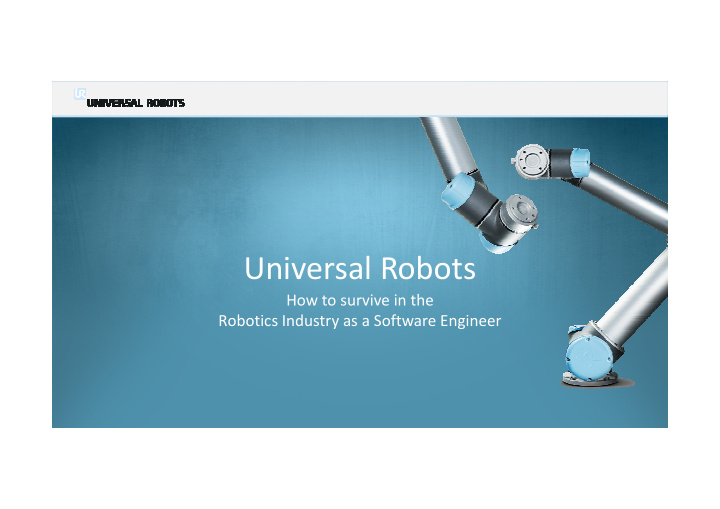



Universal Robots How to survive in the Robotics Industry as a Software Engineer
The idea Automation for Everybody � UR designs and builds revolutionary collaborative robots � Perfect for all sizes of business � UR products are so user-friendly that anyone can operate them � And so affordable that it is worthwhile for anyone to invest in them � Low total cost of ownership
The idea Robot as a Tool Our robots are made into a tool that can be used by the production staff to help them do their work better.
The idea Manual Work Outsourcing High wages Product knowledge disappears Variable quality Copying of product Problems with the Labour Inspectorate THE INDUSTRY BEFORE 1 st Generation Special Industrial Robots Machinery Big investment No flexibility Long start-up period Must be specially designed Limited flexibility
The idea Unique potential � We are used by small to very large companies – and across industries � We create growth and jobs globally � Demand for automation is high of all companies globally are SME’s
strategy Annual supply of industrial robots 1000
strategy Industrial robots by industry
strategy Applications International
Overview 2004: The idea 2005: Company founded The product 2007: First prototype – UR5 2008: First sales 2009: Distribution in DK 2010: European distribution 2011: Distribution in Asia 2012: Entered US and Launch of UR10 The business 2013: Subsidiaries in New York and Shanghai 2014: Office in Spain 2015: Launch of UR 3 and office in Singapore, Universal Robots is acquired by Teradyne for $285M
Revenue (million €) 140 120 100 80 60 40 20 0 2009 2010 2011 2012 2013 2014 2015 E2016 E2017
Global Distribution Network UR Headquarters Universal Robots subdivisions Universal Robots distribution
About the Company ~300 Employees ~300 Employees 22 Nationalities 22 Nationalities Offices in 7 Countries Offices in 7 Countries Over 300 Distributors Over 300 Distributors 20 International Awards 20 International Awards
Case stories NASDAQ bell Schunk SDH-hand Cross Automation NASDAQ / Frank Tobe
Case stories Teradyne to Buy Universal Robots for $285 Million By Angela Chen The Wall Street Journal May 13, 2015 7:35 a.m. ET Teradyne Inc. TER 1.49 % on Wednesday agreed to buy Universal Robots for $285 million in cash, in a move to expand its business with the low-cost collaborative robots. Universal Robots is a privately held Danish company that makes simple robots that usually work alongside production workers in the manufacturing process. It has been profitable since late 2010 and had $38 million in revenue in 2014, increasing more than 70% from the year before. Universal Robots is eligible to receive an additional $65 million if certain goals are met through 2018. Further financial terms weren't disclosed.
At BMW in the US
My Experiences
experience RD Makeup SW Engineer Testers Mathematicians UX Mathematicians Mechanics Designers Robotics Mechanics Robotics Electronics Electronics
Development Process • Projects per Team • Projects per individual • Team Meeting • Monthly RD Meeting • Designated Tester • Self testing • UX Designer • Self design • Process around • Limited automation automation
Past to present - and the future
Past to present History of Robotics First real The Cosmic First collaborative Robot capable of mentioning of Engine, robot assembling Clock Tower term robot wooden blocks Karel Universal Robots Freddy II Su Song Capek 1974 2009 1092 1921 3rd Cent. BC 1495 1954 1983 Philo of Da Vinci’s George Devol Byzantium Kuka Humanoid robot First digitally Washstand World’s first operated & Automaton industrial robot programmable with 6 axes - robot – Unimate. Famulus Installed at GM in 1960
Robotics Technology Development Mobility
Past to present History of Industrial Revolutions Today 1970 4th I ndustrial 4th Industrial Revolution Revolution End of 19th Century 3rd I ndustrial 3rd Industrial Revolution Revolution 2nd Industrial End of 18th Century 2nd I ndustrial Revolution Revolution 1st Industrial 1st I ndustrial Revolution Revolution
Past to present Effects of the Industrial Revolution Mass customization � Making products not on a mass scale but in a customized or personalized manner � Items suited to small number of users
Past to present Effects of the Industrial Revolution Created a gap in Manufacturing: Human aspect is now missing
Collaborative Robots The Next Industrial Revolution ADDING THE HUMAN TOUCH � Production from human to human � We want the human knowledge, creativity and customer understanding to be embedded in the products we produce � Change in manufacturing culture
The Next Industrial Revolution Change in Manufacturing • Power back to the worker • Blue-collar to Blue/White-collar production • Humans back into production in collaboration with robots • Humans do what humans do best, machines do what machines do best • Build Love/Passion into the products on the factory floor
Collaborative Robots Changes in Production BEFORE NOW � Fixed installations Relocatable � Frequent interaction Without human interaction Shared space � Separation of space Frequent changes � Repetitive work ROI short term � ROI long term
Conclusions • Software Engineers/Processes is a missing link in the robotics industry • It is not just about Robots or Automation • The possibilities and growth are massive in the industry
Questions?
Recommend
More recommend